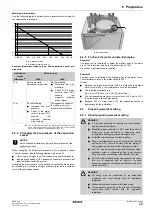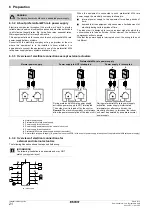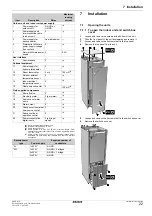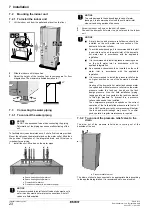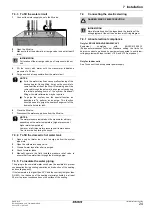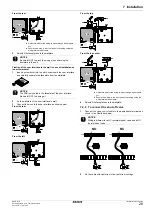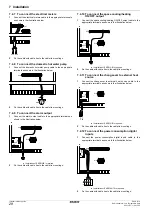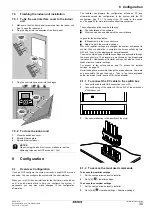
Installer reference guide
15
EHVH/X16
Daikin Altherma - Low Temperature Split
4P313777-1 – 2012.05
5 Application guidelines
5.5.2 Consumed energy
You can use the following methods to determine the consumed
energy:
Q
Calculating
Q
Measuring
Calculating the consumed energy
Q
Only applicable for EHBH/X04+08 and EHVH/X04+08.
Q
The consumed energy is calculated internally based on:
Q
The actual power input of the outdoor unit
Q
The set capacity of the backup heater and booster heater
Q
The voltage
Q
Setup and configuration: To get accurate energy data, measure
the capacity (resistance measurement) and set the capacity via
the user interface for:
Q
The backup heater (step 1 and step 2)
Q
The booster heater
Measuring the consumed energy
Q
Applicable for all models.
Q
Preferred method because of higher accuracy.
Q
Requires external power meters.
Q
Setup and configuration:
Q
For the specifications of each type of meter, see technical
data.
Q
When using electrical power meters, set the number of
pulses/kWh for each power meter via the user interface.
Consumed energy data for EHVH/X16 and EHBH/X16
models will only be available if this setting is configured.
5.5.3 Normal kWh rate power supply
General rule
One power meter that covers the entire system is sufficient.
Setup
Connect the power meter to X5M/7 and X5M/8.
Power meter type
Example
Exception
Q
You can use a second power meter if:
Q
The power range of one meter is insufficient.
Q
The electrical meter cannot easily be installed in the
electrical cabinet.
Q
230V and 400V three-phase grids are combined (very
uncommon), because of technical limitations of power
meters.
Q
Connection and setup:
Q
Connect the second power meter to X5M/9 and X5M/10.
Q
In the software the power consumption data of both meters
is added so you do NOT have to set which meter covers
which power consumption. You only need to set the number
of pulses of each power meter.
Q
See preferential kWh rate power supply for an example with two
power meters.
5.5.4 Preferential kWh rate power supply
General rule
Q
Power meter 1: Measures the outdoor unit.
Q
Power meter 2: Measures the rest (i.e. indoor unit, backup
heater and optional booster heater).
Setup
Q
Connect power meter 1 to X5M/7 and X5M/8.
Q
Connect power meter 2 to X5M/9 and X5M/10.
Power meter types
Q
Power meter 1: Single- or three-phase power meter according to
the power supply of the outdoor unit.
Q
Power meter 2:
Q
In case of a single-phase backup heater configuration, use
a single-phase power meter.
Q
In other cases, use a three-phase power meter.
NOTICE
You cannot combine calculating the consumed energy
(example: for backup heater) and measuring the consumed
energy (example: for outdoor unit). If you do so, the energy
data will be invalid.
NOTICE
When measuring the electrical power consumption, make
sure ALL power input of the system is covered by the
electrical power meters.
In case of…
Use a… power meter
Q
Single-phase outdoor unit
Q
Backup heater supplied
from a single-phase grid (i.e.
the backup heater model is
*3V or *9W connected to a
single-phase grid)
Single-phase
In other cases (i.e. a three-phase
outdoor unit and/or a 9W*
backup heater model connected
to a three-phase grid)
Three-phase
Single-phase power meter
Three-phase power meter
A
Outdoor unit
B
Indoor unit
C
DHW tank
a
Electrical cabinet (L
1
/N)
b
Power meter (L
1
/N)
c
Fuse (L
1
/N)
d
Outdoor unit (L
1
/N)
e
Indoor unit (L
1
/N)
f
Backup heater (L
1
/N)
g
Booster heater (L
1
/N)
A
Outdoor unit
B
Indoor unit
C
DHW tank
a
Electrical cabinet (L
1
/L
2
/L
3
/N)
b
Power meter (L
1
/L
2
/L
3
/N)
c
Fuse (L
1
/L
2
/L
3
/N)
d
Fuse (L
1
/N)
e
Outdoor unit (L
1
/L
2
/L
3
/N)
f
Indoor unit (L
1
/L
2
/L
3
/N)
g
Backup heater (L
1
/L
2
/L
3
/N)
h
Booster heater (L
1
/N)
b
580
1 50
0
0
c
c
f
e
d
g
A
B
C
a
b
580
1 50
0
0
g
f
e
h
A
B
C
c
c
d
a
Содержание EHVH16S18CA
Страница 84: ...4P313777 1 2012 05 Copyright 2012 Daikin ...




















